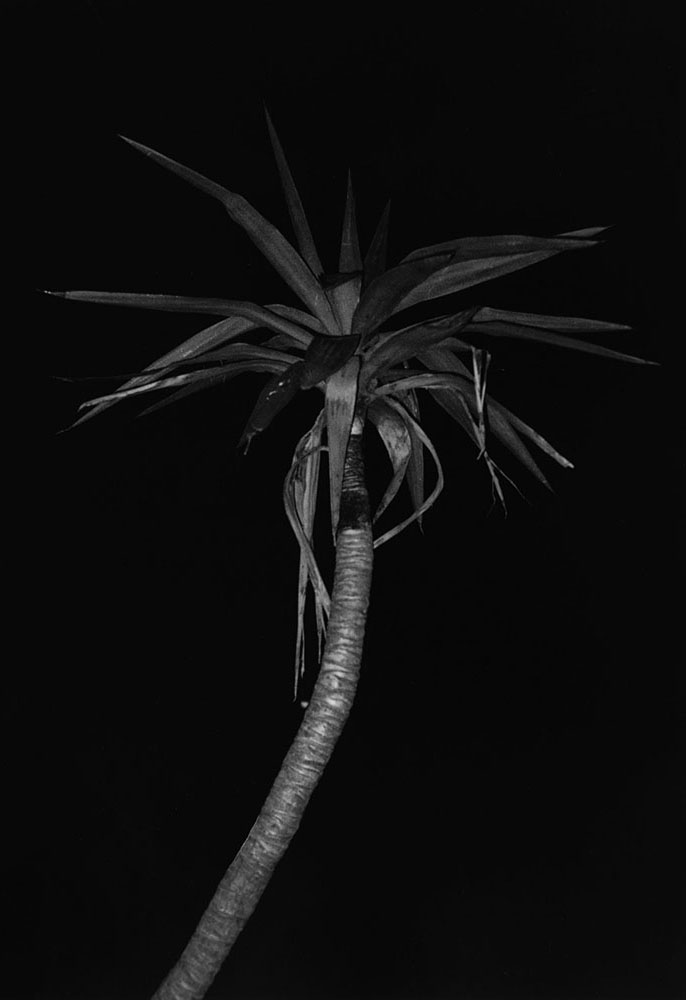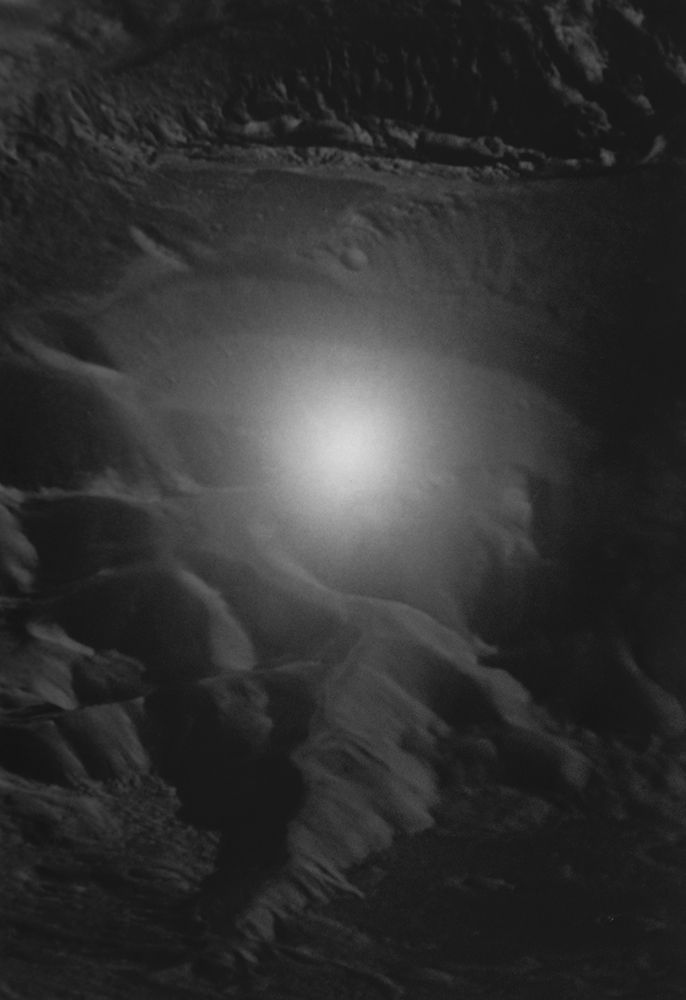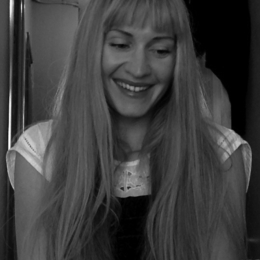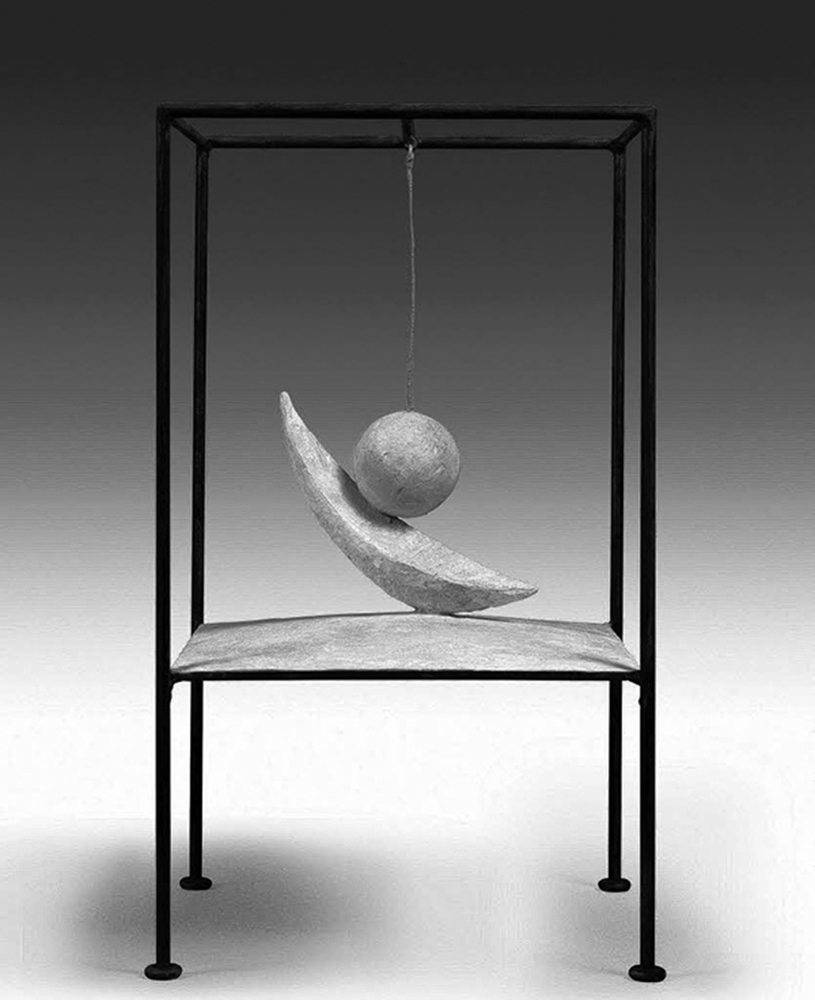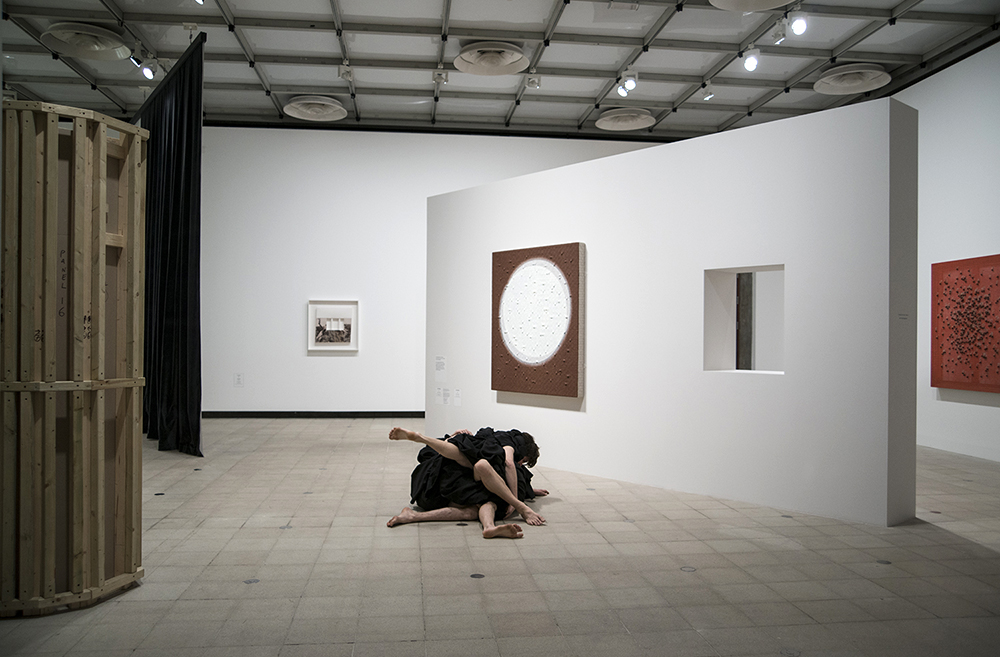Younès Klouche
Artist Feature
Every week an artist is featured whose single image was published by Der Greif. The Feature shows the image in the original context of the series.
Emma Bäcklund - Miniature Worlds
Jul 13, 2016
Like a traveller who brings back a token from her explorations, these spaces are found in the photograph. From one point to another, one may travel light years or merely within the same point. Within one point, others fragment in a continuous, repetitive pulsation just as cells never cease to stop multiplying themselves within the body. The momentum of these alternate worlds inhibit the incorporeal as much as the corporeal and the body becomes a tool to access these portals. However, a touch is not a touch in the way one might think of a touch. It is more fluid and lacks form; an ever emerging, seamless touch that must renew itself in order to continue to exist. The truthfulness of these eerie places can only exist with the touch of the eye; vision. Eyes are in the form of two hands rocking back and forth between left and right. The weight of my vision can be carried in the palm of my hand for my hands have started to share the function of my eyes. Weightlessness creates new gates for vision and experience; through these explorations I can fulfil my desire for the ‘other,’ the uncanny.
Artist Blog
The blog of Der Greif is written entirely by the artists who have been invited to doing an Artist-Feature. Every week, we have a different author.
Published in:
»Der Greif #9«
Moving Mountains
Jul 19, 2016 - Emma Bäcklund
Self-published book Moving Mountains This is a newspaper printed publication I created in relation to Offprint, Tate Modern, London, 2016. I wanted to gather images and text that had all been part of my process during a period of six months. I find it important to take time to evaluate and gather visuals and writings to better understand what I want to prioritise and focus on next. I feel there is a lot I do subconsciously and this is the time where I can recognise these intuitive aspects further. Sometimes it is a difficult thing to do as I feel eager to move on but it is also a useful and important part. Some of the works and ideas I have explored the last months I will leave behind, and some parts will become used and weaved into the next steps. Moving Mountains hints to something that seem to incorporate a heavy stillness but instead inhabit a vibrating movement. I like the idea of a volcano being so motionless yet so alive. For me a Volcano is a metaphor of both creativity and destruction, a paradox that embody rhythms of engagement and distance, pauses and flow; an active passive force. The World Upside Down When does the sky look like the sea and the sea look like the sky? The world turned upside down The sky a vast abyss The sea a burning cosmos - Yvonne Rainer, Poems, 2011 This is my last post, it has been nice sharing my thoughts with you. - Emma Bäcklund
Engagement | Distance
Jul 18, 2016 - Emma Bäcklund
Spinning top Stillness appear motionless not because it isn’t moving but because it is spinning at full speed.. Pendulum The moment in-between, the unspoken void of the pause, the instant around the event, not the event. In every sentence of writing, pauses build up a rhythm and ‘makes sense’ of its melody. The pause is the keystone in any type of rhythm or construction no matter what scale. Nothing is possible to be within a constant intensity but requires the in-between to become graspable, something one can touch upon. The pendulum swings from one side to another, a force of speed and gravity. A state of a thing which embody both intensity and release. It momentarily stops, to swing back. There are four points within this spatial momentum, A and B stretches vertically, C and D stretches horizontally. In endless motion it travels while it never travels at all. Still motion. It is about the relation between two, (twosomeness). If the pendulum only moved within one point it would no longer serve its purpose, it would no longer be a pendulum. Neither A,B,C or D makes sense in solitude, they are not excessive alone but it is the relationship between these points which creates momentum; a flow and rhythm. A suspension, concentration, paradoxically free and limited. Phantasmata Phantasmata. A sudden arrest between two movements contracting with its internal tension. The perfect balance between effort and release. Whoever wants to learn this art, needs to dance through phantasmal; note that phantasmal are a kind of corporeal swiftness that is controlled by the understanding of the measure… This necessitates that at each tempo you appear as if you had seen Medusa’s head, as the poet says; after having performed the movement, you should appear entirely made of stone in that instant and in the next you should put on wings like a falcon moved by hunger, according to the above rule, that is to say, employing measure, memory, manner with measure of ground and air. As in Domenico da Piacenza’s “dancing through phantasma,” the life of images consists neither of simple immobility nor of the subsequent return to motion but of a pause highly charged with tension between the two. -Agamben, Nymphs (Domenico da Piacenza (c. 1400 – c. 1470), was an Italian Renaissance dancing master) The Suspended Ball Alberto Giacometti’s The Suspended Ball (1930) is hanging freely while surrounded by a cage like structure, both imprisoned and free within its own boundaries. The ball inhabits a deep cut within its body, a scar or possibly an opening for breath or for entering. The half moon like form is attached to a base, stagnant while freely stretched to each sides with confidence. These forms are made for each other but can never be fully merged. The sculptures Giacometti produced almost suggests or invites the viewer to physically interact with them, which was unusual at this time in art history. Maybe he aimed to encourage the viewer to complete his own work with their physical presence and desire to touch. To fill a void. What he started to explore within the work of Suspended Ball was perhaps the consequence of his interest in existentialism and the relation man has to space and the Other; the relation one figure have within a limit of space and to other figures. Although belonging to a context, one is bound to his own solitude. The other, as absolute, the other as the desire of becoming complete, of becoming the other. Struggle A struggle does not interest me in itself, but in terms of its technical rhythm between engagement and distance and how it can be percieved for the observer. Further, the proximity to its contrary; intimacy. In this case I emphasise on a passive struggle which sometimes can be a sport, an art form or a game; a situation between two people, players, avatars etc. This subject identifies with what I have mentioned in previous posts. It also relates to what something ‘is’ and what something ‘seem like’. (Visual response). A while ago, I became interested in researching virtual spaces and how one can move through something else extended from the physical body; for instance an avatar. (Miniature Worlds). I realised that the avatars with widest range of gestures can be found in fighting games such as the game of TEKKEN. This led my google searches further into Martial arts and Capoeira. What I became interested in was the slow and focused movement of the performers.. close to an animalistic act. Around this time I thought a lot about the twosomeness I have mentioned previously, something’s opposite being its similarity, how engagement would not be engagement without its distance. I continued to look into sport forms that had never before interested me at all and become curious in the moments of standstill. In Wrestling for instance; the struggle starts to seem like a extended intimate embrace. Extreme stillness occurs, but only for the eye. Nothing is completely still, it only depends on what scale one exists within. What occurs in the wrestlers entangled bodies incorporate extreme tensity, energy, muscle activity and struggle. It happens inside. It is not energy that connects but connectedness that energises - Peter Wilberg
The Mind, Movement and Dancers
Jul 17, 2016 - Emma Bäcklund
When it’s right / nothing like it / the pieces fall / into place / not a flicker / of doubt / mars the flow / of arm / into hip / into knee / into floor / then midsection / hollowed in triumph / the whole apparatus / its discrete minds / not impending / the forward momentum / of practice / of object / no ritual here / the weight of the body / is material proof / that air is matter / and mind’s married to muscle. -Yvonne Rainer, Poems, 2011 Mind and muscle..the correlation between these two keep informing my ideas. My background and interest in contemporary dance is a result of a fascination in neuroscience. It stretches into my photographic work, which may not be obvious at first. What construct ideas of reality is connected to what we see, feel or believe in. More so, we react on visual response. The power of the image is that we can feel through it, even though we are still. This is based on muscle memory and visual response and nostalgia. (virtual reality, films etc) ‘This heart within me I can feel, and I judge that it exists. This world I can touch, and I likewise judge that it exists. There ends all my knowledge, and the rest is construction.’ (Camus, ‘The Myth of Sisyphus’) Feelings and memories gather in the body as if our limbs archive and collect emotions and experiences. Once something is repeated over and over, it eventually becomes ‘natural’. When practicing dance, this is a way to learn choreography. Repeating, repeating and repeating.. until the the mind does not ‘think’ the movement but become transformed to the muscles of the body. Muscle memory. In this way, the reverse must be possible as well. I keep coming back to a work by Jeff Wall, The Volunteer, 1996.. I relate it to this repetition that eventually becomes an automatic, robotic act. One is not actively ‘thinking’ the ‘doing’ after these repeated bodily actions. There are methods to go against inhibitions and habits of working and thinking. Writing and moving works in similar ways. Lately I have practiced automatic writing which is useful to push oneself beyond the frames of ones own image, to bring forward what is already there but limited by walls of control. Movement can too be a very controlled act, but dance is what happens when this is released and expression occurs.There is only but one moment, here. One is then intensely within ones mind but simultaneously completely free from it. I don’t believe in one-sidedness which is why I often must explore two perspectives of a thought. There is a thin line between matters of intensity and I am curious in the play between tension and release that builds up rhythm. In this context, it is the intensity and estrangement of the two entangled bodies which I find interested in Nicole Conibere’s work. I like Anne Teresa De Keersmaeker’s, Rosas, 1983, and wanted to include a still image from a video of this choreography. It is meditative to observe and one is drawn into the fast paced repetitious synchronised movements of the dancers. Yvonne Rainer is another dancer and choreographer who inspires my own work and I like her dance-poems. I have also included work by Hanna Putz, Untitled (IWAEIT), 2015 and Ilona Sagar, Soft Addictions (2014), Embassy gallery ECA, Edinburgh. Nicola Conibere Do-Re-Me (2014) A duet for art galleries and other places: unspecified duration In Do-Re-Me two figures, wrapped around each other and within swathes of fabric, negotiate a path through a given place. As fragmented limbs flail and reach for movement, the integrity of the body’s form is continually destabilised and transformed. The mass is both intensely familiar and strange: a simple shift of an arm can change its appearance from that of two distinct bodies to a seemingly impossible combination of limbs. Its performers’ physically enmeshed actions constantly provoke shifts in relation between people, material and place without resolution.
Nocturnal
Jul 16, 2016 - Emma Bäcklund
mg src="https://dergreif-online.de/www/wp/wp-content/uploads/2016/07/01-Nocturnal-589x700.jpg" alt="01-Nocturnal" width="589" height="700" class="aligncenter size-large wp-image-68050" /> “Rocking is a matter of high and low and of right and left, of the great symmetries, and alternations that govern crystals, tides, seasons, the cycles of planets and their satellites, exchanges of oxygen and carbon dioxide, captures and releases, assimilations and evacuations, nervous systems, attractions and repulsions between metals, between fauna and flora, between sexes, between stellar masses, black holes, quarks, and infinitesimal jets of dust… It is a matter, to conclude or rather to begin, of the initial beat between something and nothing, between the world and the void, which also means between the world and itself.” - Jean-Luc Nancy I Sleep The night, the absence of light. Annulled of reality as such. It is not anything nor nothing. The point between forgetting and remembering. A passage of the cosmic rhythm, a collective pulsation. A passage into the day, a space without place. It is a private act, an act removed from anything that can be called an act. It is a state of being. Private while also exposed, powerless, innocent without exits, we sleep. ‘..the impossibility of death, the universality of existence even in its annihilation’. Closing and withdrawing to another level of living removed from placeness, here there is no exterior nor boundaries, no double, no alter ego. “I” does not exist, it is timeless and unaware of its own being in space. The night can be experienced as an escape or a confrontation of ones deepest fears and desires. A sleeper refuse to adapt, and neither to compromise; one is self contained within an un-focus and an un-self, drawing into the ego that is both familiar and obscure. One is not yet familiar with oneself and never will be, these are the parts of us one visits in sleep. The night is black but blackness in itself is not black. Once eyes become accustomed to the black colours can emerge, those of the rainbow. The rainbow cannot be visible for eyes unwilling to adapt to the darkest of blacks. It is a sinking process, passive but active where one processes day and separates oneself from it. The balance of night and day, similar to a pendulum swings us back and forth while resting in standstill. The point of pause, the momentum where it momentarily stops and reaches its highest point of suspension to reverse back again, and again, in an endless repetitious swing, an ongoing agitating motion. Nocturnal Thirst emerged from her lips, slightly open but impenetrable that which lived behind her eye lids were now foggy skies, soft silhouettes and fluffy clouds The lake was serene but underneath It lived with full force ‘Lived’, she thought, ‘does it mean to keep moving’? Her face looked like stone but the stillness kept spinning
PLAY
Jul 15, 2016 - Emma Bäcklund
“Why should an art museum organise an exhibition about playgrounds? I am convinced that the two can learn a great deal from one another and are fundamentally similar in nature. Both develop their potential as clearly defined free spaces, as public places and experimental fields for aesthetics. Both invite non-professionals and insiders, children and adults to use them as laboratories in order to give their thoughts and movements free rein to experience new things, test out the unknown, and enter into relationships. They may be niches, but their subversive potential is not to be underestimated.” - From the publication The Playground Project, produced in relation to the exhibition at Kunsthalle Zürich with the same title. These photographs are from the exhibition “The Playground Project”, Kunsthalle Zürich 20.02.2016-16.05.2016, and from the beautiful publication with the same title that I recently bought. I started to research around ideas of play, gestures and play theory after experiencing a dance performance at Sadlers Wells, London in March. The performance was by Anna Teresa De Keersmaker; “Rosas, golden hours (as you like it)”. Sitting there, I began to visualise arrested motions within the movements, ideas of still images. After that I begun to research play theory further and became curious in the subject, specially the slippage between seriousness and creativity. Previous theories implied that play would be ‘apart’ from reality. Robert Caillois defines play as a free and voluntary activity that occurs in a pure space, isolated and protected from the rest of life. I believe that play is what is very much part of life and strives culture forward. Play can open up the possibility of re-figurations and development, and that creativity is a crucial part of positive psychology and social interactions. After working with people and gestures within the photograph, the embodied play developed into a fascination in structures, scaling off the bodily presence to an interest in its structural proportions, its negative space. I began to observe my surroundings such as playgrounds, gym machines, product design, architecture and shapes in an urban environment. This is what developed into the photographs in my last post “Re:formed (Inoperative)”. It is merely the beginning of an ongoing project I intent to explore during this summer and into my last year of studying MA Photography at the Royal College of Art. I will continue to build sculptures based on activities performed through the body and functionality to later emerge in the flatness of the photograph. - Emma Bäcklund
Re:formed (Inoperative)
Jul 14, 2016 - Emma Bäcklund
Familiar structures built to exist in the photograph. The forms reminisce of domestic shapes related to functionality, that which must mirror the scale and proportions of the body in order to complete its function. I am interested in observing shapes and structures in an urban environment, built to adapt to the bodily. What happens when removing it from its context, or altering its form? Modifying a form slightly can remove it from its initial function in relation to human measurements. To place it in the photograph detaches its functionality further. Images appear without a body but echoes its measurements and reminds one of the familiar, the known. Intimacy and separateness, struggle and embrace. Often, one can not be without the other. The photographs inhabit a twosomeness, a flat coldness while simultaneously an unsettled closeness. One is left with an image that does not give away all at once. Printed life-size, the viewer is placed within these proportions. - Emma Bäcklund




